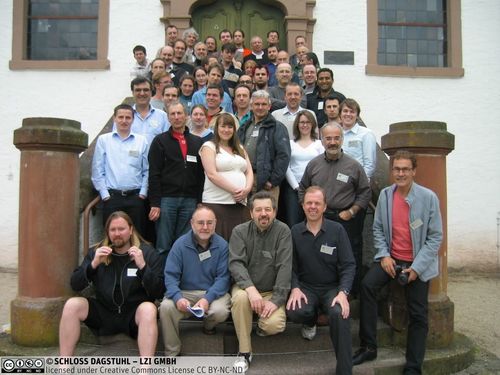Dagstuhl Seminar 06221
Computational Aesthetics in Graphics, Visualization and Imaging
( May 28 – Jun 02, 2006 )
Permalink
Organizers
- Bruce Gooch (Northwestern University - Evanston, US)
- László Neumann (University of Girona, ES)
- Werner Purgathofer (TU Wien, AT)
- Mateu Sbert (University of Girona, ES)
Contact
The Dagstuhl-Seminar on Computational Aesthetics in Graphics, Visualization and Imaging took place from 28 May until 2 June, 2006, with 54 registered participants and some visiting PhD students from Germany. The high interest in the topics dealt at the seminar resulted in a tight scheduling of presentations and panel discussions. The program, according to the Dagstuhl tradition, was finished during the seminar. We have seen 36 presentations, and organized discussions in smaller groups at the last day of the seminar, summarizing the results and trends, and looking for answers of open questions and for application areas of computational aesthetics.
This seminar had some really important results. It was the second meeting of this topic, after the First EG Workshop on Computational Aesthetics in Girona, Spain, May 2005. At the closing session of the successful seminar it was evident that this new interdisciplinary area has already its international community established, containing mostly widely known high level researchers, their groups of students, and people from industry. Computational aesthetics has grown over its pioneer age, and became slowly a new discipline based on the techniques, algorithms of overlapping subfields of the computer imagery.
Computational Aesthetics has built new bridges and fruitful interactions between the different areas of computer imagery, and it represents a practical, new quality or meta-level. This new quality is similar to the relation of individual cars and the question of traffic regulation, safety, and control of the highways. In producing the first generation of cars these aspects or levels were not important and really predictable.
The perceptual, cognitive and artistic meta-level represented by computational aesthetics ensures in the future the communication between the researchers of computer imagery techniques, and the artist and designer community. For these people the algorithmic details are basically not really interesting, they need practical tools, e.g. in the visualization, printing, painting, movie industry, CAD systems, architecture, and other application areas.
The panel discussions have dealt with the following questions trying to address them regardless of the subfield (NPR, modeling, HDRI, color, etc...):
- What is Computational Aesthetics?
- What are the metrics in computational aesthetics? What about evaluation of success?
- What are the degrees of freedom and precision of intensioning in the field of computational aesthetics? Which are the constraints?
- Suggest unique workshop/conference formats for following up this Dagstuhl meeting
- Can we take the human out of the loop? At what point does this happen?
- How can we engage/incorporate art & design (and other) communities?
- What is the ‘Holy Grail’ of Computational Aesthetics? What are the grand challenges?
- Visual styles (only?) achievable by computer? (i.e. if we don't just repeat what artists have done, considering the field of computational aesthetics, what can we create? what is enabled?)
- Applications?
- Where does Computational Aesthetics come in: algorithm/process? Content? Intent? Observer?
The high interest of participants, the inspiring discussions, a lot of new ideas and the results demonstrated the impulse and potential of this rapidly launching area. The successful seminar will be continued in form of annual conferences, and further Seminars on Computational Aesthetics will be held in the future.
- Dirk Bartz (Universität Tübingen, DE)
- Stefan Bruckner (TU Wien, AT) [dblp]
- Martin Cadik (Czech Technical University in Prague, CZ)
- Sheelagh Carpendale (University of Calgary, CA) [dblp]
- Alan Chalmers (University of Bristol, GB)
- Daniel Cohen-Or (Tel Aviv University, IL) [dblp]
- Douglas Cunningham (Universität Tübingen, DE) [dblp]
- Oliver Deussen (Universität Konstanz, DE) [dblp]
- David S. Ebert (Purdue University - West Lafayette, US) [dblp]
- Thomas Ertl (Universität Stuttgart, DE) [dblp]
- Miquel Feixas (University of Girona, ES)
- Giovanni Gallo (University of Catania, IT)
- Georg Glaeser (Universität für Angewandte Kunst - Wien, AT)
- Amy Gooch (Northwestern University - Evanston, US)
- Bruce Gooch (Northwestern University - Evanston, US)
- Susanne Grabowski (Universität Bremen, DE)
- Gary R. Greenfield (University of Richmond, US)
- Eduard Gröller (TU Wien, AT) [dblp]
- Knut Hartmann (Universität Magdeburg, DE)
- Donald H. House (Texas A&M University - College Station, US) [dblp]
- Victoria Interrante (University of Minnesota - Minneapolis, US) [dblp]
- Tobias Isenberg (University of Calgary, CA) [dblp]
- Pauline Jepp (University of Calgary, CA)
- Joaquim A. Jorge (Technical University of Lisboa, PT) [dblp]
- Eric Joris (Antwerp, BE)
- Craig S. Kaplan (University of Waterloo, CA)
- Caroline Larboulette (TU Wien, AT)
- Dani Lischinski (The Hebrew University of Jerusalem, IL)
- Céline Loscos (University College London, GB) [dblp]
- Kresimir Matkovic (VRVis - Wien, AT) [dblp]
- Gary Meyer (University of Minnesota - Minneapolis, US)
- Klaus Mueller (SUNY - Stony Brook, US) [dblp]
- Karol Myszkowski (MPI für Informatik - Saarbrücken, DE)
- Frieder Nake (Universität Bremen, DE) [dblp]
- Attila Neumann (TU Wien, AT)
- László Neumann (University of Girona, ES)
- Georg Petschnigg (Microsoft Research - Redmond, US)
- Xavier Pueyo (University of Girona, ES)
- Werner Purgathofer (TU Wien, AT)
- Ramesh Raskar (Mitsubishi Electric Research Laboratories (MERL), US) [dblp]
- Erik Reinhard (University of Bristol, GB)
- Jaume Rigau (University of Girona, ES)
- Mateu Sbert (University of Girona, ES)
- Stefan Schlechtweg (Universität Magdeburg, DE)
- Hans-Peter Seidel (MPI für Informatik - Saarbrücken, DE) [dblp]
- Efstathios Stavrakis (TU Wien, AT)
- Georgios Stylianou (University of Cyprus, CY)
- Pere-Pau Vazquez (UPC - Barcelona, ES) [dblp]
- Ivan Viola (TU Wien, AT) [dblp]
- Daniel Weiskopf (Simon Fraser University - Burnaby, CA) [dblp]
- Alexander Wilkie (TU Wien, AT)
- Brian Wyvill (University of Calgary, CA)


